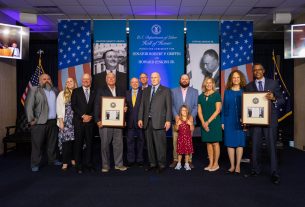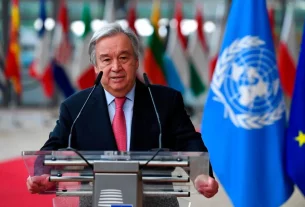|
Getting your Trinity Audio player ready...
|
Above the Arctic Circle in Finland’s municipality of Inari, the largest and most sparsely populated region of Finnish Lapland, leading sources of income are tourism and the cold-climate testing of cars, tyres and components.
The country’s north-south “European Route”, the E75, brings in year-round visitors seeking the beauty and serenity of an uncrowded natural environment almost 300 kilometres north of the Arctic Circle. In 2019, an estimated half a million people visited the region, which has only twilight in winter and 24 hours of daylight in summer.
Culture clash
Inari is also Finland’s capital of Sámi culture, a cornerstone of which is the herding of reindeer by the indigenous community. That means the region faces a challenge in balancing respect for traditional customs and openness to 21st century jobs and revenue.
‘Indigenous peoples have been reindeer herding for hundreds of years,’ said Pasi Rautio, a research professor at the Natural Resources Institute Finland. ‘It is not just a livelihood, it’s a way of life – a culture.’
Rautio, who comes from Finland, leads a research project that received EU funding to try to reconcile the often-competing demands on the resources of the Arctic from both inside and outside the area. Called ArcticHubs, the four-year project is due to wrap up in July 2024.
The researchers want to ensure that the use of natural assets such as open waters, timber and critical minerals by outside economic or political actors doesn’t come at the expense of local residents and traditions.
These customs also include fish farming, which can be harmed by foreign competition, and hunting, which can be disrupted by the construction of infrastructure such as wind farms and mines.
A Lapland resident himself, Rautio has the impression that global or national players are eyeing the region’s resources without showing adequate consideration for local communities.
‘It’s seen as a place to excavate,’ said Rautio. ‘But not enough investments are feeding back into the local people and local communities.’
In 2023, Swedish state-owned mining company LKAB said it had found the largest deposit of rare-earth minerals in Europe. While these minerals are important for the West’s green transition, the Sámi way of life including migration routes and grazing lands would be disrupted by the mining activities if they go ahead.
Another example of increased foreign interest in the Arctic is provided by China, which has invested more than €84 billion above the Arctic Circle in infrastructure, assets and other projects – much of it in the energy and minerals sectors.
Local voices
While Arctic countries themselves have primary responsibility for such issues, EU and international cooperation can help address them because they include cross-border aspects.
For example, while Earth as a whole is increasingly feeling the effects of climate change, the Arctic is warming four times faster.
“
It’s seen as a place to excavate.
The loss of snow cover means less energy is reflected into space and more solar radiation is absorbed at the Earth’s surface, leading to a faster and more intense rise in temperatures. That in turn gives Europe and the rest of the world a stake in the wellbeing of the region.
For the past three years, Rautio and his colleagues have been interviewing residents across the area – Finland, the Faroe Islands, Greenland, Iceland, Norway and Sweden – and collecting information to help guide local, national and EU policymakers.
The aim is to ensure that any future licenses for the commercial use of natural resources heed the long-term interests of residents.
The team has been mapping the resource and land needs of local residents and businesses.
They’re grouped into clusters representing five activities where the challenges and effects of Arctic development are most tangible: forestry, mining, fish farming, tourism and indigenous culture.
The researchers have already reached one important conclusion: to ensure the sustainable use of land and water, it is crucial to involve the affected communities, local institutions, researchers and policymakers.
The goal is for decisions taken to be inclusive, transparent and broadly representative. In Finland, current practices reflect this effort.
If, for example, foreign investors are considering logging in forests where the Sámi practice reindeer husbandry, the state consults the herders as part of a process that requires consensus for the project to go ahead and regional or local decision-makers can give their views about whether the Sámi’s livelihood is being taken into account.
The researchers are providing reports to municipal authorities and European Parliament members on what’s at stake when resource licences are granted and channelling grassroots information into high-level strategy documents such as the EU’s Arctic policy.
The ultimate goal is to reconcile and pre-empt land-use conflicts.
Fair way
How to ensure fair and sustainable development in the Arctic region is also a preoccupation of Dr Corine Wood-Donnelly, a researcher at Uppsala University in Sweden.
She led another EU-funded project that investigated the viability of Arctic economic activities. Called JUSTNORTH, the project ended in November 2023 after three and a half years.
“
It is possible to move towards more just outcomes.
It set out to determine who really stands to benefit from increased exploitation of the Arctic.
‘Whom is this for?’ said Wood-Donnelly. ‘It’s not going to work to just keep extracting and doing what we’re already doing over and over again. We’re just going to end up with a ruined Arctic.’
The project brought together a range of partners to examine specific cases of economic activity in the Arctic.
Among the participants were academic researchers, indigenous communities and local business owners, while the cases included mining activities in Finland, transportation in Iceland and tourism ventures across the Arctic, among others.
Risks and rewards
The project identified economic-development risks and costs as well as benefits and opportunities.
For example, building wind farms in the vast open fields of the Arctic could bring economic development to the region because of the energy they would generate.
But because of the low temperatures, the windmills would accumulate ice that would then fall onto the fields, according to Wood-Donnelly. That would make these areas hostile to both reindeer, which could no longer graze there, and tourists, who would be unable to ski or hike on the land.
The case studies led to data and findings used to produce policy briefs. In addition, the team used its findings to inform national politicians and EU policymakers themselves.
For example in 2020, when the European Commission was holding a public consultation on the EU’s emerging Arctic policy, Wood-Donnelly said her colleagues took the opportunity to provide insights.
‘People on the project have been advising government ministers and other policymakers,’ she said. ‘There’s a lot of local or regional influence shaping how to think about development in the Arctic.’
As with Rautio under ArcticHubs, Wood-Donnelly said sustainable development of the region requires communities to be involved in policy decisions of all kinds – from projects as large as an energy investment to as small as construction of a single road.
‘It is possible to move towards more just outcomes,’ she said. ‘There are so many small, measurable ways to achieve these.’
Research in this article was funded by the EU’s Horizon Programme. The views of the interviewees don’t necessarily reflect those of the European Commission. If you liked this article, please consider sharing it on social media.



